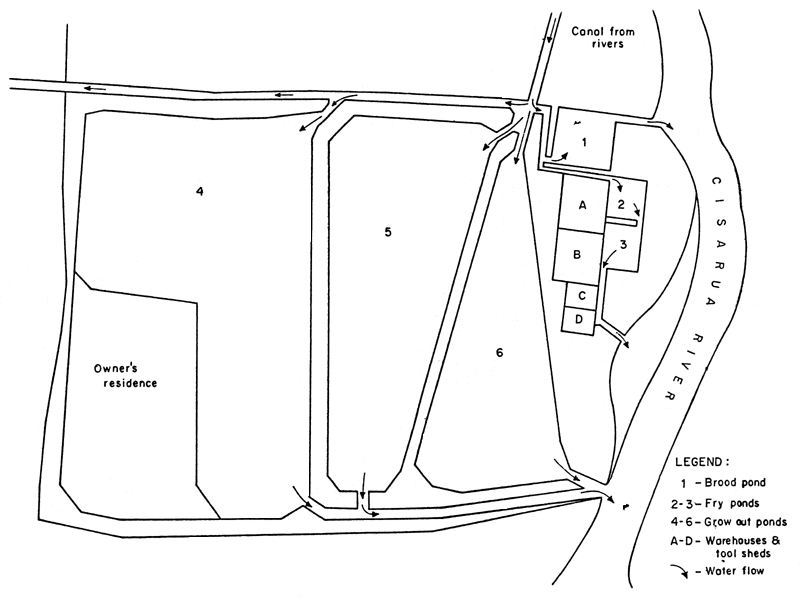The common carp, Cyprinus carpio, is a very popular table fish in Indonesia and as such is widely cultured to meet the steady consumer demand. The culture method involves the growing of carp fingerlings to marketable size in earthen ponds using water from rivers, irrigation canals or plain rain water. One method uses the same pond water during the whole growing period. Another uses river water entering and going out of the pond in a continuous flow during the entire growing period. The latter is the method used in a pond project in Gunung Jaya, Sukabumi, Indonesia (Figure 4).

Figure 4. Layout of the free-flowing pond in Gunung Jaya, Sukabumi (Not to scale)
The project has a total area of 1 400 m2 within which is a total water area of 800 m2 . Water from a nearby river enters the project by way of a ditch, dug by the owner, and flows out into a creek running beside the property. Both inlet and outlet are of concrete with adjustable gates. The project's water is kept at a depth of 130 cm. Water flow is 300–500 1/sec.
The owner has invested a total of Rp 2 million using only his own funds though government credit financing is available on a priority basis - maximum of Rp 3.6 million/100 m2 for a free-flowing pond with intensive feeding. The owner used the amount to buy the original tract of land and to construct his residential house and the pond complex within.
The project's brood pond contains 30 females, each weighing a minimum of 3 k and 10 males, each weighing a minimum of 1 k. These breeders are rented out to fish farmers, 3 brood males and 1 brood female in a batch.
Twenty to thirty days after the breeders are rented out, the project is paid its fee of 50 percent of the fish seeds produced. On a monthly basis, this averages 7 000 fish seeds of 2–3 cm long. These first stage fish seeds are again rented out to other carp fish farmers. After 30–60 days, the project is paid its fee of 50 percent. By then, these second stage fish seeds would weigh an average of 100 g each. Due to an average mortality of 20 percent, the project normally receives only 2 000.
The second stage fish seeds are then placed in any of the project's growing ponds. If all are already stocked, the fish seeds are either placed in a holding pond or are sold for Rp 1 300/k.
The foregoing is not the usual system of operating a free-flowing pond. Most projects do not have auxiliary hatcheries. They concentrate their efforts on raising fish seeds to marketable size in grow-out ponds. Fish seeds are purchased from the government or privately-owned hatcheries.
In the grow-out ponds, the fish seeds are stocked at the rate of 6–12/m2 . They are fed daily a pelletized commercial feed, available locally, at the minimum rate of 3 percent of body weight, Feeding is done through a 10-k capacity self-feeder costing Rp 5 000. The project consumes feed at the rate of 24 k/day at Rp 250/k.
The carps grow to a marketable size of 1/2–1 k in 3–4 months. Depending on his cash position and also to maximize production, the owner sometimes skims the crop of a pond and sells only the big ones first.
Information supplied by the staff of the Directorate General of Fisheries of Indonesia show that there are about 2 200 units of free-flowing ponds engaged in culturing carps in the country. West Java alone has 1 200 units. Each unit has an area of 80–100 m2 and each produces carps amounting to 5–20 MT/year.